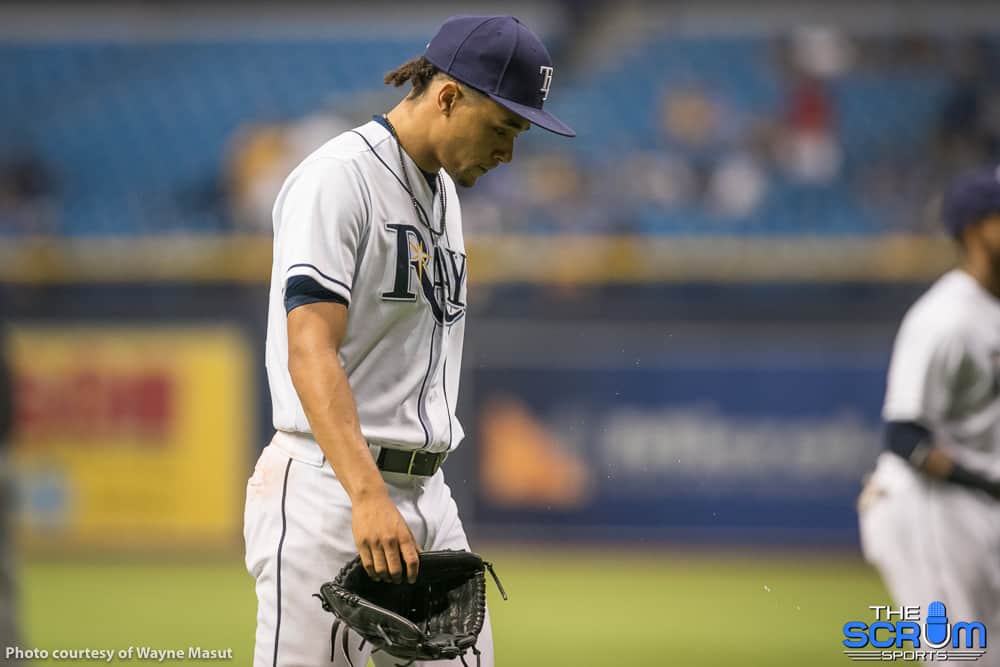
Well, it’s definitely not too soon.
For the past few offseasons, winter meetings, trade deadlines, and years in general, trade rumors have swirled around two time all-star Chris Archer.
But when you look at his pure stuff, which include a high 90’s fastball and a wipeout slider, and compare it with his numbers–an 11.1 career bWAR and a lifetime 106 ERA+–there’s a clear disconnect. Yet, Archer remains a highly coveted, tightly held asset for a Rays franchise that has endured 4 straight losing seasons. Even though the Rays have always been known to ‘listen in on anyone and everyone,’ Archer seems too tough to let go. But why?
Maybe it’s the asking price. They reportedly wanted more than the White Sox wanted for Chris Sale at one point. Maybe the Rays think he is better then the game level numbers suggest. Maybe the Rays think that when their competitive window opens, he will finally be the pitcher they hoped he would be. The pitcher to lead the rest of the staff with his experience and wisdom.
But after a 2018 start in which he’s allowed 21 runs in his first 27.1 innings, the Rays are at a stalemate with the former budding star’s market. But how did this all start? Why do the Rays, and the rest of the league, think Archer is so great? What has he even done?
On January 8, 2011, the Rays traded Matt Garza, Fernando Perez and Zach Rosscup to the Chicago Cubs for Archer, Sam Fuld, Brandon Guyer, Robinson Chirinos and Hak-Ju Lee. What a haul! Garza, at the time, was coming off his worst season as a Ray despite a 15-10 record. The Cubs, pre-Theo Epstein, clearly overpaid for a player who gave them two and a half slightly above average years. Archer, however, was all the rage, and would make his major league debut later that year.
Each year following, he would get better.
And then came 2015, the year Archer went from rising star to all star. Even though he always had elite stuff, it wasn’t until ’15 when he became an elite pitcher. Archer would finish that season 6th among American League pitchers in WAR (4.1), 2nd in strikeouts (252), and 5th in the Cy Young voting. It was in this season that the Rays traded David Price with the confidence that Archer would fill his shoes.
But then 2016 came, and the same pitcher who was getting better every year, stopped getting better. The strikeouts remained, but were countered by a slight uptick in baserunners allowed and a drastic increase in HR/9–0.8 in ’15 to 1.3 in ’16. Even though we was still a league average pitcher, his season netted him an unsightly 9-19 record.
But this is when the trade talks heated up.
Archer’s underwhelming performance led the ’16 Rays to a 68 win season, the lowest season win total since they wore green and had ‘Devil’ in their name. Thinking the Rays would go into a full rebuild, this was only part of the reason teams started calling.
For one, the advanced metrics suggested a bounce back season in 2017. Advanced metrics such as FIP, as well as his ability to strike hitters out said the upside was still there. More importantly, he was in the 4th year of one of those ‘team friendly’ extensions, set to make just south of $5 million. If a team were to acquire him and bring him back to his ace like form, it would be the bargain of the century.
But the Rays held on.
And in 2017, the Rays would be better. Archer’s good, but not great, first half would give him his second all star selection. The Rays were contending for a playoff spot. Come deadline time, they would load up the bullpen, acquire a big bat, and look to continue competing.
So the Rays held on.
As we know, however, the Rays, and Archer, played poorly down the stretch. Though Archer showed more flashes of his old self in ’17, he would finish the season only slightly better than the year before (101 ERA+ in ’17 compared to 100 in ’16).
And then came the offseason. The Rays famously traded Evan Longoria, Corey Dickerson, Jake Odorizzi and Steven Souza. If you’re gonna tank, tank all the way, am I right? Still making a relatively low salary, and coming off his third consecutive 200+ inning season, Archer still had upside. Surely he would be dealt, too.
But the Rays held on.
Now, the Rays carry a No. 1 starter who owns a ERA North of 6 and has regressed so far in his ability to get strikeouts, the one thing he had going for him. Archer, who turns 30 in September, has now been a league average pitcher for two years. Whoever looks to acquire him would need to give up a prospect package similar to the one he was once a part of, and would need to pay him a portion of his $6.75 million salary this year, as well as $7.5 million next year, which, for a league average pitcher, now seems expensive.
If Archer can bounce back, however, so with the Rays, but so will his trade value. It’s a literal catch-22
If not, the Rays will hold on.





